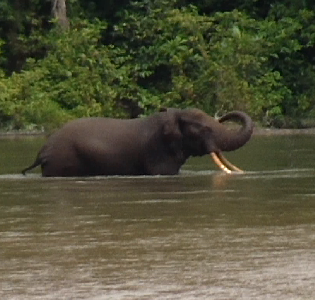Cantilevered out over the Mpassa River, the platform provides a wonderful view of a bend in the river and the sandbar surrounded by places for elephants to drink mineral water. From here we can see the ARU (autonomous recording unit) that we have used to monitor elephant activity over the last two years.
In most particulars this site is just like any other 'bai': mineral access, an opening where family units can meet and interact, a place where individuals can find mates. But different because it is a big river with a strong current. Last night a nice big male with heavy tusks was up to his hips in the river when we arrived. Over and over again he first squatted down, then apparently knelt on the river bottom in order to get his trunk down into a mineral pit. At times he was completely under, but his butt kept popping up and an occasional tail-twitch gave away his position. (I will put a video here when I get somewhere that can handle the upload!)
A bit later in the afternoon a female group arrived; two adult females each with a calf. On of these calves ws probably 7-8 years old, the other maybe about 4 years. Strange that there was not a very young calf with either female. The group materialized across the deep channel where the male was diving and immediately went into the river. They swam a bit, then the females got to a point where they could stand. The two calves kept going toward the middle of the river and the sand bar. I expect they didn't like fighting the current where their mothers stopped to drink - perhaps exhausting for them to hold their position against the current when their feet barely touched bottom and with their lighter bodies.
A few years ago Nicolas Bout, a colleague of mine here in Gabon, observed this 'diving' behavior and wrote a short note for publication, interpreting that the elephants were after minerals. Some reviewer of the note rejected this as unconfirmed so the note was refused. But my video clearly shows identical behavior sequences to elephants in typical forest clearings. The females were sometimes in shallower water where is was clear that they were on their knees (as often seen in the Dzanga clearing in Central African Republic), forcefully pushing trunks into the bottom of the river, blowing out air and then pausing. Then up to drink. I think I will have to join forces with Nicolas and submit the note again!


